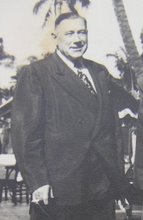The Manila Chronicle
by Phillip Sexton
December 15, 1952
As we don't really need anyone to tell us, getting enough to eat is the major problem of the Far East, with the exception of the small, rice-growing areas of the Southeast Asia mainland. Among other things, the Philippine Republic needs a way not only to increase her own rice output, but also to get the most out of what she has. The NARIC which is this country's rice buyer, has been repeatedly rocked with very disconcerting scandals, and some of the rice stocks, for which such huge amounts were payed out in foreign currency, found to be infested. The nation sorely needs a radical departure from the present system of growing, administering and storing her cereal.
We have a man with us in the Philippines now who may be able to answer many pertinent questions for us. He has been here for over one year, I am told, and yet, I don't recall having read a single line about him anywhere, which seems to me as being a remarkable thing, under the circumstances. His name is Erich. G. Huzenlaub, the cereal technician who invented the "rice conversion process." The Reader's Digest once termed his process a "revolution in rice." The United States has had, for several years, one of the largest mills in the world, at Houston, Texas, given over entirely to the Huzenlaub Process. I have been amazed to find that the Research Director of the U.S. Army Quartermaster Corps, announced that rice "conversion was "one of the most significant and scientific developments of World War II." Still, Huzenlaub has evidently led a very quiet existence in Manila, for an extended period of time.
I am not going into the scientific data of the process, but I do think that you would like to know just what the "conversion" accomplishes. After treatment, the rice has a high percentage of natural vitamins B-1 and B-2. It is immune to infestation, and can be stored for years, without becoming uneatable. The breakage (of rice) is considerably less than under the ordinary milling, and the quality is supposedly far better than other artificial systems such as "parboiled" and "enriched" rices.
The part that really struck me was the fact that "converted" rice can be stored indefinitely. After Huzenlaub invented his process, he designed a commercial demonstration in London, which operated for five months, in 1939. At this demonstration, he used some Thai palay, which was several years old, and broken into small, moldy bits.
The Thai minister watched the "conversion" himself, and then ordered his entire Embassy staff to live on the "converted" rice for one month. At the end of this experiment, the Thai minister announced that he had found the rice equivalent to fine five percent broken, Thai White Rice, and that if he himself had not actually watched the original, old palay being "converted," he would never believe that such a thing was possible.
Huzenlaub was the one who built the huge plant in Texas, and trained the personnel for its operation. A year after it was producing, the U.S. Defense Plant Corporation granted it a loan for about $800,000 which boosted its capacity to around 50,000 metric tons. At the same time, the U.S. Office of Price Administration classified this "converted" rice as "essential for the war effort."
It appears that Huzenlaub wants permission to build a "conversion" plant and mill in the Philippines. He says that he can get it financed by American capital, and all that he would like to do is show the country that his process is a major solution to the rice problem here. It seems to me that he has the facts and figures to back himself up. What is more, he is able to point his plants in highly successful operation elsewhere in the world.
A technician of Huzenlaub's apparent talents deserves thorough hearing in the Philippines. If he can unquestionably confirm the information that has been passed on to me, there is no telling how profoundly the rice picture here might be effected. Let's get onto it. Heaven knows there is nothing to lose.
Copyright 1952. The Manila Chronicle. Philippines.

No comments:
Post a Comment